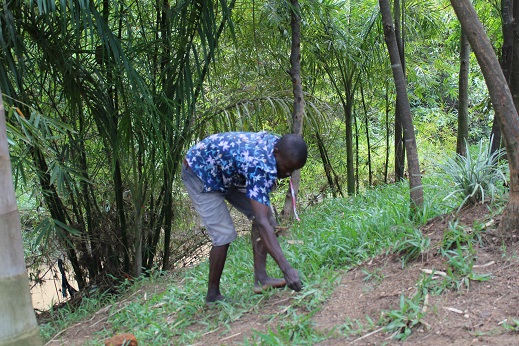
By John Riaga | oukoriaga@gmail.com
When Silas Otieno, 39, was asked to abandon his daily trade of sand harvesting from River Kibos in Kisumu County, western Kenya, it did not make a lot of sense to him.
He had spent the better part of his life diving into the waters and emerging with buckets full of sand. He would do this alongside his peers from Komonge Village until it was enough to fill one lorry. From these proceeds, he would feed his family and send his children to school.
When the parcel of land riparian to the sand harvesting site was bought and fenced off, Otieno lost his daily income from sand harvesting but got a deal for a monthly salary. He now works as the lead conservationist of the environment that he once took part in destroying.
Unknown to Mr Otieno and his peers, they actively contributed to the devastating effects of climate change that has now got the whole world talking.
According to the United Nations Environment Programme (UNEP), sand mining from rivers and marine ecosystems has led to significant environmental impacts, including river erosion, shrinking deltas, land-use changes, air pollution, salinisation of coastal aquifers and groundwater reserves, threats to freshwater and marine fisheries and biodiversity.
Oblivious of the effects of their actions, many people continue to harvest sand from rivers, not just in Komonge Village but throughout Kenya.
Human activities such as sand mining have been cited by climate change experts as the leading effect on greenhouse gases (GHGs).
Paul Oloo, the Kisumu County Meteorological Director, says human activities had increased the concentration of the GHGs tremendously.
He says the initial ability of the earth to self-regulate the GHGs had been compromised as a result of their concentration levels being interfered with due to issues like accelerated population growth and the large expansion of industries across the earth.
“In its self-regulation mechanism, if for instance the amount of radiation hitting the surface of the earth is 100 units, the same is supposed to be released back into the atmosphere,” Mr Oloo explains.
However, due to the disruption of the concentration levels of the GHGs, a percentage of the radiation is not able to leave the surface of the earth. “This is what increases the temperatures on the earth surface” he says.
With riverbank erosion, air pollution and the threat to biodiversity, it is not difficult to tell that the future of the residents of Komonge village is disturbingly endangered if the wanton sand harvesting is not stopped.
Retired teacher Leonard Ating’a stands at the edge of his farm wondering how his parcel that used to stretch into the river has shrunk in size over the years.
“My parcel used to go beyond where I stand now, but the river, over the years has kept moving farther into my land and that of my neighbours here,” says Ating’a, 81.
Just next to him, there are two huge gaping holes on the farm. They caved in as a result of sand harvesting.
How the harvesters dug out the sand underneath his vegetables farm is beyond his understanding.
Thanks to efforts being made by Otieno on the adjacent parcel being turned into an eco-tourism resort by planting of trees and grass along the hitherto destroyed shores of River Kibos, there is hope for Ating’a and his neighbours.
“I had no idea about climate change and how sand harvesting was encouraging the dire situation. I was only fending for my family.
Now that I know better, I am leading the fight to end sand harvesting here and ensure we restore our natural resources and the ecosystem here,” says Otieno.
In 2009, the Kenyan government issued sand harvesting guidelines that were meant to regulate the industry.
This was as a result of the widespread problems caused by sand harvesters at river banks, wetlands and even road reserves.
The National Environment Management Authority (NEMA) Kisumu County Director Tom Togo says there are plans to turn the guidelines into law to make them more effective.
“The guidelines as they are, are not binding legally and those who infringe them cannot be held liable. But if we successfully turn them into law, we shall be able to deal with the issue of wanton sand harvesting effectively,” says Mr Togo.
Oloo says that while it would take time to reverse the effects of climate change, it is important for people to resort to adaptation measures to try and mitigate those effects.
“It is not possible to eliminate climate change; we can only adapt,” he says.
Oloo says 90 per cent of natural disasters around the world are climate change related. Since human activities are the main causes of climate change, it therefore means that human beings must be at the centre of efforts to mitigate it.

Leave A Comment